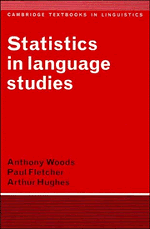Book contents
- Frontmatter
- Contents
- Preface
- 1 Why do linguists need statistics?
- 2 Tables and graphs
- 3 Summary measures
- 4 Statistical inference
- 5 Probability
- 6 Modelling statistical populations
- 7 Estimating from samples
- 8 Testing hypotheses about population values
- 9 Testing the fit of models to data
- 10 Measuring the degree of interdependence between two variables
- 11 Testing for differences between two populations
- 12 Analysis of variance – ANOVA
- 13 Linear regression
- 14 Searching for groups and clusters
- 15 Principal components analysis and factor analysis
- Appendix A Statistical tables
- Appendix B Statistical computation
- Appendix C Answers to some of the exercises
- References
- Index
11 - Testing for differences between two populations
Published online by Cambridge University Press: 05 June 2012
- Frontmatter
- Contents
- Preface
- 1 Why do linguists need statistics?
- 2 Tables and graphs
- 3 Summary measures
- 4 Statistical inference
- 5 Probability
- 6 Modelling statistical populations
- 7 Estimating from samples
- 8 Testing hypotheses about population values
- 9 Testing the fit of models to data
- 10 Measuring the degree of interdependence between two variables
- 11 Testing for differences between two populations
- 12 Analysis of variance – ANOVA
- 13 Linear regression
- 14 Searching for groups and clusters
- 15 Principal components analysis and factor analysis
- Appendix A Statistical tables
- Appendix B Statistical computation
- Appendix C Answers to some of the exercises
- References
- Index
Summary
It is often the case in language and related studies that we want to compare population means on the basis of two samples. In a well-known experiment in foreign language teaching (Scherer & Wertheimer 1964), first-year undergraduates at the University of Colorado were divided into two groups. One group was taught by the audiolingual method, the other by the more traditional grammar–translation method. The intention was to discover which method proved superior in relation to the attainment of a variety of language learning goals. The experiment continued for two years, and many measurements of ability in German were taken at various stages in the study. For our present purpose we will concentrate on just one measurement, that of speaking ability, made at the end of the experiment. Out of a possible score on this speaking test of 100, the traditional grammar–translation group obtained a mean score of 77.71 while the audiolingual group's mean score was 82.92. Thus the sample mean of the audiolingual group was higher than that of the grammar-translation group. But what we are interested in is whether this is due to an accidental assignment of the more able students to the audiolingual group or whether the higher mean is evidence that the audiolingual method is more efficient. We will address this question by way of a formal hypothesis test.
Independent samples: testing for differences between means
The notation we will use is displayed in table 11.1.
- Type
- Chapter
- Information
- Statistics in Language Studies , pp. 176 - 193Publisher: Cambridge University PressPrint publication year: 1986



